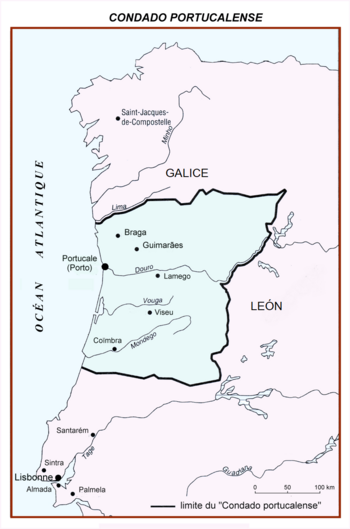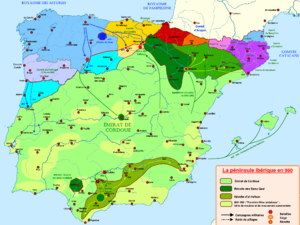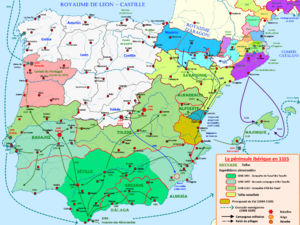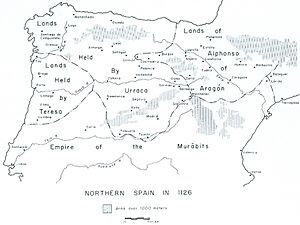County of Portugal facts for kids
Quick facts for kids
County of Portugal
|
|||||||||||||||
|---|---|---|---|---|---|---|---|---|---|---|---|---|---|---|---|
| 868–1071 1096–1139 |
|||||||||||||||

Second County of Portugal
|
|||||||||||||||
| Status | County within the Kingdoms of Asturias, Galicia, and León | ||||||||||||||
| Capital | Guimarães (868–1131) Coimbra (1131–1139) |
||||||||||||||
| Common languages |
|
||||||||||||||
| Religion | |||||||||||||||
| Demonym(s) | Portuguese | ||||||||||||||
| Government | Feudal monarchy | ||||||||||||||
| Count of Portucale | |||||||||||||||
|
• 868–873
|
Vímara Peres (first of the first county, from the House of Vímara) | ||||||||||||||
|
• 1050–1071
|
Nuno II Mendes (last of the first county, from the House of Vímara; Annexation to the Kingdom of Galicia | ||||||||||||||
|
• 1096–1112
|
Henry (first of second county, from the house of Burgundy) | ||||||||||||||
| History | |||||||||||||||
|
• Established
|
868 | ||||||||||||||
| 1139 | |||||||||||||||
| ISO 3166 code | PT | ||||||||||||||
|
|||||||||||||||
| Today part of | Portugal Spain |
||||||||||||||
The County of Portugal was a special area in medieval times. It was located around the cities of Guimarães and Porto. This region is now part of northern Portugal. It was here that the identity of the Portuguese people first began to form.
There were actually two different counties with this name. The first one existed from the mid-800s to the mid-1000s. It was like a smaller state connected to the Kingdom of Asturias, Kingdom of Galicia, and Kingdom of León. This first county ended because of a rebellion.
Later, a new, larger County of Portugal was created in the late 1000s. Its leader eventually turned it into an independent country. This independent country became the Kingdom of Portugal in the mid-1100s.
Contents
The First County of Portugal (868–1071)
The story of the first County of Portugal began in 868. This was when a leader named Vímara Peres took back the city of Portus Cale (which is now Porto) from the Moors. This event was part of the Reconquista, a long period when Christian kingdoms in Iberia fought to retake lands from Muslim rule.
King Alfonso III of Asturias made Vímara Peres a count. He gave him control of the border area between the Limia and Douro rivers. This area became the County of Portugal.
Expanding the Frontier South
Later, another border county was formed south of the Douro River. This was the County of Coimbra. It was also taken from the Moors. This pushed the frontier further south, away from the County of Portugal.
However, the County of Portugal still faced many attacks from the Caliphate of Córdoba. In 987, the city of Coimbra was lost again to a leader named Almanzor. This meant the County of Portugal was once again on the southern border of the Leonese kingdom.
The lands to the south were finally retaken during the rule of Ferdinand I of León and Castile. Lamego was captured in 1057, Viseu in 1058, and Coimbra in 1064.
Powerful Counts of the First County
The leaders of the first County of Portugal became very powerful in the late 900s. Count Gonzalo Menéndez might have even used the title "grand duke of Portugal." His son, Menendo González, also used a similar title.
Count Gonzalo Menéndez had some disagreements with King Ramiro III of León. This happened after the king refused to fight against Vikings who attacked Gonzalo's lands in the 960s.
Menendo González, Gonzalo's son, had a good relationship with King Bermudo II of León. Menendo became an important advisor and teacher to Bermudo's son, who would later become King Alfonso V of León. Menendo even served as a regent, helping to rule for the young King Alfonso.
The End of the First County
The County of Portugal had different levels of independence within the Kingdom of León. Sometimes it was part of the Kingdom of Galicia. This continued until 1071.
In that year, Count Nuno Mendes wanted more independence for Portugal. He fought against King García II of Galicia. Nuno Mendes was defeated and killed in the Battle of Pedroso. After this victory, King García II declared himself "King of Galicia and Portugal." This was the first time Portugal was mentioned in a royal title.
The independent county was then ended. Its lands became part of the Kingdom of Galicia. Later, Galicia itself became part of the larger kingdoms ruled by García's brothers, Sancho II and Alfonso VI of León and Castile.
The Second County of Portugal (1096–1139)
In 1093, King Alfonso VI gave his son-in-law, Raymond of Burgundy, control of Galicia. This area included what is now Portugal, stretching south to Coimbra. However, Alfonso still kept the title of "king" over these lands.
But King Alfonso became worried about Raymond's growing power. So, in 1096, he decided to split Portugal and Coimbra from Galicia. He gave these lands to another son-in-law, Henry of Burgundy. Henry was married to Alfonso VI's daughter, Theresa.
Henry chose Guimarães as the main city for this new county. It was called the Condado Portucalense. This second county would last until Portugal became fully independent. Its territory covered much of present-day Portugal, between the Minho River and the Tagus River.
Steps Towards Independence
Count Henry continued the Reconquista in western Iberia. He expanded the lands of his county. He also got involved in political plans within the Leonese court. He worked with his cousin Raymond and sister-in-law Urraca of Castile. Henry supported Raymond in exchange for promises of more freedom or even independence for Portugal.
In 1111, the Muslims captured Santarém. When Count Henry died in 1112, many people in the County of Portugal wanted independence. Henry's wife, Theresa, took charge for her young son. She even used the title "Queen" for a short time. However, she was defeated by her sister, Queen Urraca, in 1121. Theresa then had to accept that she was still under the rule of the Leonese state.
Her own son, Afonso Henriques, took control of the government in 1128. He defeated his mother's forces in the Battle of São Mamede, near Guimarães. After this battle, he started using a seal with a cross and the word "Portugal." He continued to win battles, supported by the nobles of the region.
A New King for Portugal
Even after his victories, Afonso Henriques did not immediately call himself "king." He used titles like "prince" or "infante." This showed that he knew his power still depended on the consent of King Alfonso VII of León. He also avoided using the title "count," which would show he was dependent on the king of León and Castile.
His big victory came in the Battle of Ourique in 1139. After this battle, his troops declared him King of Portugal. Finally, in 1143, King Alfonso VII of León and Castile officially recognized Portugal's independence. This was done through the Treaty of Zamora.
Leaders of the County of Portugal
These are the important leaders who ruled the County of Portugal.
First County: House of Vímara
- Vímara Peres (868–873)
- Lucídio Vimaranes (873–924)
- Hermenegildo González (c.924–c.950)
- Mumadona Dias (c.924–c.950)
- Gonzalo Menéndez (c.950–997)
- Menendo González (997–1008)
- Alvito Nunes (1008–1015)
- Nuno Alvites (1017–1028)
- Ilduara Mendes (1017–1028, as regent for her son)
- Mendo Nunes (1028–1050)
- Nuno Mendes (1050–1071)
Second County: House of Burgundy
Images for kids
See also
- Portugal in the Middle Ages
- Portugal in the Reconquista







